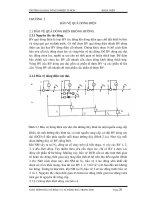Experiment 2 settling
Bạn đang xem bản rút gọn của tài liệu. Xem và tải ngay bản đầy đủ của tài liệu tại đây (84.83 KB, 3 trang )
CIVL375 Experiment 2
Settling in Secondary Clarifiers (Type III and IV)
Introduction:
Flow entering the secondary clarifier (after aeration) in a wastewater treatment plant
consists of large concentration of particles. Settling of these particles occurs at two
stages. First, particles will settle in what is referred to as zone or hindered settling (Type
III). Second, particles accumulating at the bottom will undergo a compression settling
(Type IV) where the particles are too close that settling occurs by compaction.
The main objective of this experiment is to design a secondary clarifier for a wastewater
treatment plant and determine the sludge volume index (SVI). SVI is defined as the
volume (in ml) occupied by 1 gram of activated sludge after 30 minutes of settling. SVI
is used by treatment plant operators to regulate sludge pumping rate from the secondary
clarifier. A low SVI (i.e., 35-150) is supposed to indicate a good settling sludge and,
therefore, a low return sludge pumping rate. SVI is computed as:
SVI =
Volume of settled sludge after 30 min (ml )
× 1000(mg / g )
suspended solids (mg ) in 1 − liter cylinder
To design the surface area of a secondary settling tank, two areas need to be determined:
(1) the area required for clarification (Ac). This area is determined from the slope
of the settling curve at early settling time such that
Ac =
Q
vo
where Q is the flow rate and vo is the overflow rate (i.e. slope of the line of the settling
curve at early settling times)
(2) the area required for thickening (At). This area is determined by first finding tu
from the settling curve using the procedure outlined in the curve below. Note that to find
tu you need to know the underflow design concentration (Cu) of the thickened sludge. Cu
usually ranges from 10,000- 20,000 mg/l. By knowing Cu then
Co Ho=Cu tu
Co is the initial suspended solids concentration and Ho is the height of the cylinder. Now
the area needed for thickening can be determined:
Q= At Ho/tu
Sample Identification:
Wastewater entering the secondary clarifier at Zakher Wastewater Treatment Plant.
Procedure:
1. Mix the sample container well and take a sample to determine the suspended solids
concentration (Co) using the filtration method. Take duplicate or triplicate samples and
then average.
2. Bring a 1-L graduated cylinder and measure the depth in cm to the 1000 ml mark.
Also, measure the internal diameter of the cylinder.
3. Bring a stop watch
4. Mix the sample container well and pour in 1 liter of sample in the cylinder
immediately.
5. Start timing
6. Monitor the interface as it settles and record the depth and time.
Requirements:
1. Fill out the provided experiment data sheet and carry out the required calculations.
2. If you are requested to submit a report of this experiment then your report should
contain (a) an introduction that ends with the objective (b) methodology including sample
identification (c) results and discussion (d) conclusion (e) references and (f) an appendix
that contains the filled data sheet.
CIVL 375: Experiment 2 Data Sheet
Settling in a Secondary Clarifier (Type III and IV)
Attending Group Members
Name
ID
Experimental Conditions
Experiment date
Sample collected from
Sampling date
Graduated cylinder height, cm
Graduated cylinder diameter, cm
Initial suspended solids, mg/l. Trial 1
Initial suspended solids, mg/l. Trial 2
Initial suspended solids, mg/l. Trial 3
Average suspend solids, mg/l
Sludge Interface Height
Time
Height
(min)
(cm)
Time
(min)
Height
(cm)
Time
(min)
Height
(cm)
Required Calculations
1. Determine the SVI
2. Plot the settling curve and determine the surface area of the settling tank assuming the flow rate is 1000
m3/day and the underflow concentration (Cu) is 15,000 mg/l.









